Ten figures clambered over piles of rubble from the old cotton warehouse, picking up bricks. It was a cold day for Selma, Alabama, close to freezing, and as the sun disappeared they gathered to warm their hands over makeshift fires. For 10 hours they removed bricks from piles mixed with wood and metal, chipping each recovered brick free of mortar, and then stacked them. The bricks were handmade in the 1870s, and a foreman was paying them between $10 and $20 in cash for a pile of 500.
It was hard work. A pile took about half the day to gather, and most quit from fatigue after one go. An older man watched them: “Everyone heard about this job, but few want to do it, because it pays nothing, and lots of people been hurt doing it. But there are no jobs here in Selma. Especially if you got a record, and almost everyone in Selma has a record.” Nobody knew who owned the old warehouse, although most reckoned it was a white man: “They own everything around here.”
A brick buyer from a construction firm came to look at the pile. “Handmade bricks, especially historical ones like this, are in demand. They often sell for over a dollar per brick.”
Jennifer had spent the day picking bricks, and wasn’t complaining, “I am a single mother with five kids. I will do any work, and this is the only work in town.”
A man on a break, his hands bleeding beneath a cloth wrap, smoked a cigarette. “This is slave work, that’s what it is, but the only work around. Kind of funny when you think about it, because them bricks were probably made by slaves. That is Selma for you, though: still a city of slaves.”
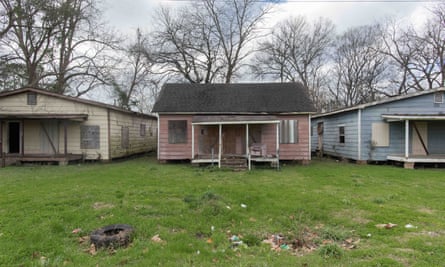
Driving towards Selma, you are constantly reminded by historical markers that although once a city of slavery, the city now symbolizes civil rights. The march to secure voting rights for African Americans in 1965 originated there, and is celebrated in a film named after the city.
Crossing over the river into Selma is another reminder; the Edmund Pettus Bridge is recognizable from newsreels of Bloody Sunday, when marchers were beaten by the police, or from last year when President Obama came to mark the 50th anniversary of that day. The central street beyond the bridge is three short blocks filled with shops catering to tourists.
Yet if you walk beyond those blocks you see the ugliness of poverty that is modern Selma: dilapidated and boarded-up homes tagged with gang symbols, empty lots littered with vodka bottles and fast-food wrappers, and sterile low-income projects. You see men clustered on corners selling drugs, and on the better-kept homes you see sign after sign urging, “Stop the violence”. You don’t see working factories, only empty ones being torn down for scrap.
You see a population disenfranchised, economically and politically. It makes Selma, a symbol of past civil rights victories, a symbol of current civil rights failures.
The black sociologist William Julius Wilson, in his 1987 book the The Truly Disadvantaged, wrote about the underclass, a term he uses to describe those living in urban poverty. In it he argues, “the central problem of the underclass is joblessness.” In the afterword to the 2012 reissue he acknowledges that, “Racism put blacks in their economic place, but changes in the modern economy make the place in which they find themselves more and more precarious.”
In the US, joblessness for African Americans is roughly twice that of whites. In Selma, which is 80% African American, joblessness runs even higher. In 2010, unemployment in Selma reached 20%; it has since been cut in half to 10%, but still around twice the national average. Wages in Selma (as for African Americans nationally) also badly lag the country, with the median family income at roughly $25,000 – half that of the US average.
There are countless theories offered by academics and politicians about why African Americans disproportionately suffer higher joblessness and lower wages – a lack of education, dependence on manual labor, technological shifts – but to many Selma residents those theories are just excuses for racism.
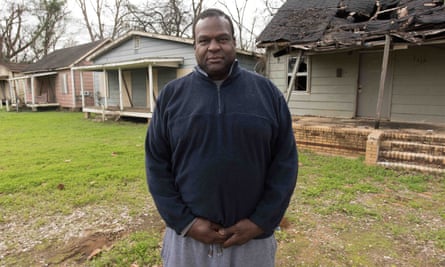
Marcus, 55, moved to Selma when he was a baby. “Everyone always saying we don’t have jobs because of things we lack, but it ain’t what we lack, it’s what we have: black skin. When I was a boy we had to cross through the white neighborhood to get to school, and they used to sic the dogs on me and my younger sister. I left Selma and joined the military. When I came back, nothing much changed. They don’t sic dogs on you any more, but they stack so much against you that it might as well just be dogs.”
Council McReynolds, 52, has spent his entire life in Selma, and wishes he could leave. “All the factories that used to be here are closed: the candy factory, the furniture company, they all picked up and moved when we elected a black mayor.”
His house is one of only two on the long block that isn’t abandoned and boarded up. The one next to his is half-burned-down, the others sit empty, although a few people squat in them. “Selma ain’t like that movie. There everyone is shown working together and putting the past behind them. But the reality is Selma has been left behind, and folks are certainly not working together.”
When I asked him about one of the empty buildings next to his, he smiled, “That ain’t empty at all. There is a family living there, being charged by a landlord.”
Council’s block is not an anomaly in Selma. Boarded-up or falling-down houses make up about a quarter of the city. Many other buildings, which in other places would be considered derelict, with broken windows, porches filled with holes, are stunningly being used as rentals.
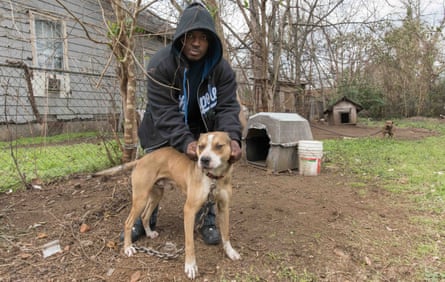
Most people do what they can legally do to get by. Michael, 45, makes extra money raising dogs. “I also deliver meals to the elderly. It is a good job, but doesn’t pay enough to cover raising kids. I won’t sell drugs, like so many others do, so I raise dogs.”
State senator Henry Sanders, 73, who represents Selma, is more blunt in his views: “You can’t talk about Selma, and you can’t talk about the African American experience in America, without talking about the legacy of slavery.”
Sanders was born in rural Alabama, one of 13 children. He laughs when he is described as coming from humble origins. “Humble? I was born straight-up poor, or as we say, po’. Thirteen kids sharing room po’.”
Inspired by the US’s first African American justice, Thurgood Marshall, he put all his energies into education, eventually attending Harvard Law School. After graduating in 1971, he came back to Selma. “Me and my wife came here inspired and determined to make things better. We had such high hopes, and thought it would improve and maybe five years later we could move on, but it never happened.”
When asked why, he talks about the closing of the adjacent Craig air force base in the 1970s, and politics. “The statewide political establishment is overwhelming Republican, white and male. It isn’t that they don’t care about African Americans, it’s that they don’t even think about them, unless it is in negative terms. As a result, everything in Alabama is tougher for African Americans. As we say, when the white community catches a cold, the black community gets pneumonia. Despite all of that, when you talk about jobs in Selma, you also have to talk about the drugs and jails.”
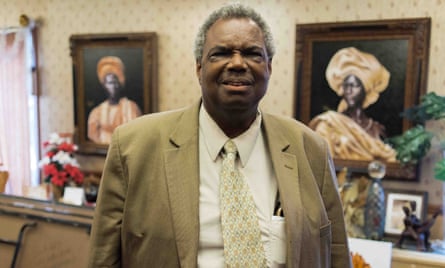
Like many poor communities, Selma has a drug problem. In the absence of traditional job opportunities, using and dealing drugs has filled the void. Magnifying the problem are Alabama’s aggressive policies – it has some of strictest drug laws, and the second highest incarceration rate in the US – policies that disproportionately affect the African American community.
It has turned Selma into a city where having a felony conviction seems almost normal.
A cluster of six men gathered at a friend’s house, beneath Selma’s water tower proclaiming “Selma, a great place to live”. All had felonies; most were for marijuana possession or dealing. One man, who had just been released from prison, explained: “In Alabama they will throw you in jail for just standing in your yard holding a joint.”
Getting a felony in Alabama means carrying a burden for the rest of your life. “Once I got my felony, I became the walking dead. I couldn’t do nothing. I couldn’t vote, I couldn’t drive, and I sure as hell couldn’t work, so I sat around doing nothing, until I started selling again.”
Like most people I met in Selma, none wanted their picture taken. “No picture in Alabama ever did a black man a favor.”
With the illegal drugs comes violence, as dealers settle disputes with guns, not lawyers. It has all only further distanced Selma, and its residents, from legal opportunities – few companies are going to move there when crime is so high.
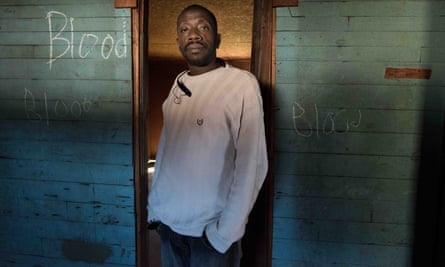
Melvin Barnes, 39, met me in the low-income projects that surround the Brown Chapel AME church, a historical landmark that was center of the voting rights march. He grew up in Selma, started dealing at 17, and got caught up in the street life.
“Everyone around me had guns, everyone around me dealt, and I got caught up in it. I got a gun when I was 14, carried it around, and shot it a lot. Everyone did.”
Seven years ago, he got into a “street altercation” that ended with a bullet meant for him almost hitting a child next to him. “I came home from that, and looked at my child, and hugged him. I knew I had to stop the game.” He quit drugs and now hosts a daily radio show, and works the streets, urging others to stop the violence.
Melvin took me to the old abandoned home he sleeps in when homeless. “I haven’t had any money since I quit dealing, nobody is gonna give a former drug user like me a job.”
At the spot where we talked, Antoine Stallworth was shot and killed only a few yards away from the church two weeks before on New Year’s Eve. It was the last murder in Selma of 2015, bringing the total to 11, and making Selma (population about 20,000) one of the most violent cities in the US, with murder rates more than 10 times the national average.
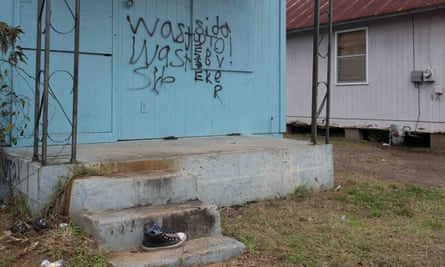
My last two days in Selma were spent with Escrow, 34 (named changed), who has four felony convictions, for drugs, guns and attempted murder. He moved to Selma at the age of 14, brought to live with his grandmother by a mother addicted to crack. When he shook my hand, he smiled, flashing a row of missing teeth, “Welcome to the real hood. Selma don’t play games.”
He has been shot six times and shot many others. “I don’t know how many times I shot at people. I am just a shooter, always have been.”
He talks quietly and methodically, only stopping to sell drugs – “excuse me, I got to make a deal”.
When I ask about guns in Selma, he grimaces. “When I got here, everybody had a gun, everybody was shooting. I needed to be like them. I learned quickly you got to escalate, or guys will see you as weak, and shoot you dead, so I escalated.”
He always carries a gun, except when on his block.

In the two days I spent with him, in some of the roughest parts of Selma, around open drug deals, I never once saw any police. When I commented on this, another dealer spoke: “The police here are corrupt as anything. One offered me to sell for him, but second you do that, then they own you, and you are their bitch.” Everybody else I spoke to on the streets agreed.
Escrow knows he doesn’t have long outside, but assumes the end will come from another dealer’s gun, not from the police. “I want to get out of this life, but to do what? Ain’t no jobs here. I got no skills and four felonies, who is gonna hire me? And the minute I drop my gun and put on a McDonald’s outfit, someone gonna pop me, for being weak.”
At the end of my last day in Selma, exhausted from seeing so much pain, I sat outside the Brown Chapel AME church, watching kids play, and making small talk with a group of men. I went to take a picture of the kids, and forgetting their age, started my normal interview, “Do you like Selma? What was it like growing up here?”
They all looked at me confused, except one girl, Robin, aged nine. “No I don’t like Selma. Not at all. Too much shooting and my momma can’t find a job. That is why we are moving to Florida.”
As I photographed the kids in front of the sunset, a BMW pulled up. Two tourists got out to look at the Brown chapel. The gang of men, including Escrow, watched them, wondering where they were from. I went over and talked to the tourists who were from Ontario and excited to see places they knew from the movie, but concerned about their safety.
When I came back and told the men where the tourists had come from they all whistled in proud disbelief. “Damn, CANADA. Wow. They came all the way from Canada to see Selma?”
I also mentioned their fears of the neighborhood. Escrow stopped playing with his phone, looked at me, eyes drilling into me, smile gone.
“We never harm tourists. Never. Got that. We keep our shit to ourselves. They come here because special things DID happen here. Just wish they would happen again.”
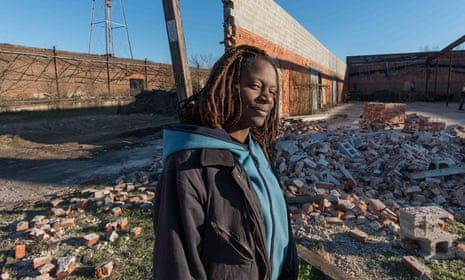
Comments (…)
Sign in or create your Guardian account to join the discussion